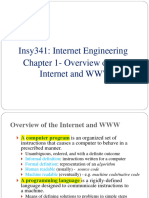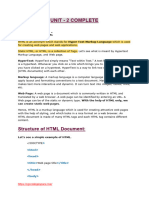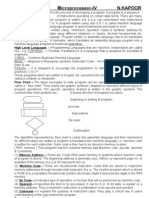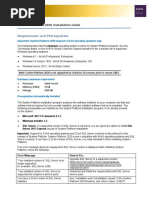HTML Theory + Lab
Uploaded by
ASK 011HTML Theory + Lab
Uploaded by
ASK 011HTML
HTML is an acronym which stands for Hyper Text Markup Language, The
Language of Web Pages on the World Wide Web.
HTML is used to create web pages and web applications.
We can create a static website by HTML only.
Extension > .htm or .html
www –World Wide Web.
HTML is a text formatting language.
URL – Uniform Resource Locator.
History of HTML
In the late 1980's , a physicist, Tim Berners-Lee who was a contractor at CERN,
proposed a system for CERN researchers. In 1989, he wrote a memo proposing an
internet based hypertext system.
Tim Berners-Lee is known as the father of HTML.
The first available description of HTML was a document called "HTML Tags" proposed
by Tim in late 1991.
The latest version of HTML is HTML5, which we will learn later in this tutorial.
Features of HTML
easy and simple language.
markup language, so it provides a flexible way to design web pages along with
the text.
It facilitates programmers to add a link on the web pages (by html anchor tag),
so it enhances the interest of browsing of the user.
It is platform-independent because it can be displayed on any platform like
Windows, Linux, and Macintosh, etc.
It facilitates the programmer to add Graphics, Videos, and Sound to the web
pages which makes it more attractive and interactive.
HTML is a case-insensitive language, which means we can use tags either in
lower-case or upper-case.
Types of Applications
1) Single user------ This application run on the one machine and can be used on the
same machine.
Hence Scalability (increase number of users) is the problems
2) Web application---These applications are 3 tier applications; the application is
deployed(loaded) on the web server. And can be accessed on client machine via
browser.
Web Service---Any application which runs on server, connects to the database, and
return data, either in JSON (JavaScript object Notation), XML (Extensible markup
language), text format, are called as web service.
Usually used in B2B (Business to Business ) communication.
tier application
When we send the request via browser
http://google.com/mail URL→ protocol://domain
name/uri
http://172.0.12.3 url-→protocol://ipaddress:port
number/uri
http://localhost:9090/MyApp/ The data after ? is called as
login? query string
uname=user1&role=admin&bt
n=test
HTML4 vs HTML5
What is bold vs italic vs strong
HTML VALIDATION End module
You might also like
- Introduction Toweb Development & HTML (Cs220)No ratings yetIntroduction Toweb Development & HTML (Cs220)47 pages
- Give History of Web Development and Emphasis On Growth Rate of Web and Web Servers?No ratings yetGive History of Web Development and Emphasis On Growth Rate of Web and Web Servers?7 pages
- Internet: Internet Programming Chapter One: The FundamentalsNo ratings yetInternet: Internet Programming Chapter One: The Fundamentals10 pages
- Acknowledgement: Overview of Online Buy and SellNo ratings yetAcknowledgement: Overview of Online Buy and Sell34 pages
- Unit I: Introduction To Web DevelopmentNo ratings yetUnit I: Introduction To Web Development28 pages
- NICT Computer Education Pvt. LTD.: Internet & HTMLNo ratings yetNICT Computer Education Pvt. LTD.: Internet & HTML33 pages
- Web Technology Study Material GTU - 23042016 - 032646AM PDF100% (1)Web Technology Study Material GTU - 23042016 - 032646AM PDF82 pages
- Maseno University Department of Information Technology CDIT 406: Web AuthoringNo ratings yetMaseno University Department of Information Technology CDIT 406: Web Authoring7 pages
- Yellow Black White Modern Doodle UI Computer Pitch Deck Marketing PresentationNo ratings yetYellow Black White Modern Doodle UI Computer Pitch Deck Marketing Presentation13 pages
- News Shopping Images Videos Books Search ToolsNo ratings yetNews Shopping Images Videos Books Search Tools3 pages
- Technical Manual MDT Shutter Actuator: JAL-01UP.02 JAL-0210.02 JAL-0410.02 JAL-0810.02 JAL-0410D.02 JAL-0810D.02No ratings yetTechnical Manual MDT Shutter Actuator: JAL-01UP.02 JAL-0210.02 JAL-0410.02 JAL-0810.02 JAL-0410D.02 JAL-0810D.0283 pages
- "Railway Management System": Submitted in Partial Fulfillment For The Award of TheNo ratings yet"Railway Management System": Submitted in Partial Fulfillment For The Award of The32 pages
- 2021 P5 English Semestral Assessment 2 ST NicholasNo ratings yet2021 P5 English Semestral Assessment 2 ST Nicholas30 pages
- safety-at118_-en-p Safety Mat Stop Safety FunctionNo ratings yetsafety-at118_-en-p Safety Mat Stop Safety Function24 pages
- Requirement and Prerequisites: Aveva Intouch 2020 Installation Guide100% (2)Requirement and Prerequisites: Aveva Intouch 2020 Installation Guide6 pages
- PRINT Career Planning Fill in Guide For StudentsNo ratings yetPRINT Career Planning Fill in Guide For Students12 pages
- Tp-Link Tl-Wa855re Quick Setup Tl-Wa855re - Qig - v4No ratings yetTp-Link Tl-Wa855re Quick Setup Tl-Wa855re - Qig - v42 pages
- Know Salesforce: Want To How To Pass CRT-450 ExamNo ratings yetKnow Salesforce: Want To How To Pass CRT-450 Exam17 pages






























































































